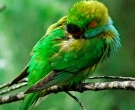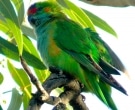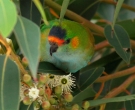Content |
|---|
Description
The Purple-crowned lorikeet (Parvipsitta porphyrocephala) has a length of 16 cm.. and a weight between 40 and 50 g..
The part forward of the crown is orange, merging is in red in the lores. Above and in front of the eyes, orange-yellow. Crown dark purple color, merging into green at the nape, also showing a few feathers of orange-red.
The ear-coverts, yellowish-orange, Red Centre. Chin and throat, of color turquoise light.
Upperparts, of color green with washed Brown in the the mantle and rump more bright, slightly greenish-blue.
The upperwing green color, bright blue marked in the curve and on the edge of the carpal area.
The interior of the flight feather color black; fine yellow margins in primaries.
Coverts interiors, red. Breast
, neck and upperparts, of color green with a wash light blue turquoise; sides chest top with slight brownish wash; Center of belly washed turquoise with flanks and coverts, of color color green; yellowish stains on the bottom sides of the chest hidden with the wing folded. Green the upper part of the tail and yellow on the inside.
Its small bill curved is black, their legs grayscale and the irises her Brown eyes.
The female is similar but has the irises darker, the ear-coverts lighter and lacks crimson spots.
The immature are more muted tones and lack of purple coloration of the head.
- Sound of the Purple-crowned lorikeet.
Habitat:
It is a nomadic local that often are found in the forests dried sclerophyllous, especially when the eucalyptus Bloom.
Nomadic flocks may also travel far, Sometimes the inside of the Australian continent.
The flowering of the eucalyptus is mainly responsible of its movements unpredictable, Although in some areas, the birds may be present throughout the year.
Found in diverse areas forming large flocks of hundreds of individuals, often with groups mixed from others Lori including the Musk Lorikeet.
Found commonly in Woods and forests, but also visitors are urban areas, where feed on ornamental flowers.
Casual visitors during the winter of banksias in habitats of Heath.
The Purple-crowned lorikeet is characteristic of drier areas, lightly lined, especially eucalyptus Woods.
Can convert it in a plague to the orchards.
Roosts in large groups, sometimes very far from the feeding areas. Manso and discreet While feeds, except the constant calls. Usually feed on low branches and shrubs.
Reproduction:
The breeding season It includes the months of August to December. The nests are located in holes in trees, preferably a eucalyptus near the water. Several couples often occupy neighboring holes in the same tree.
The cycle of of reproduction in captivity gives a period of incubation of around 22 days, with the young people of 6 to 7 weeks weaned high is after the hatching.
Food:
Feed primarily of nectar and pollen of the flowering of the eucalyptus, but they can also attack the orchards to feed on ripe fruit.
Distribution:
Size of the area of distribution (reproduction / resident): 938.000 km2
The Purple-crowned lorikeet are located in two areas separate from Australia to the Southwest and Southeast of the continent. Separate ranges, but racial differences are not recognized, and it is possible that the birds can travel from time to time between the two areas of distribution. Also located in the Kangaroo Island, Although not found in Tasmania.
Conservation:
• Current IUCN Red List category: Least concern
• Population trend: Decreasing
The world population It is believed that it is superior to 50.000 individuals.
This species has a very large range, and therefore not approaching the thresholds for Vulnerable according to the range size criterion.
While the trend of the population seems to be decreasing, the descent do not believe that it is sufficiently fast for approaching the thresholds of Vulnerable according to the criterion of population trend.
For these reasons, the species is evaluated as Least concern.
"Purple-crowned lorikeet" in captivity:
It is a bird noisy, sociable and always in motion.
Very rare in captivity out of Australia.
Alternative names:
– Purple crowned Lorikeet, Purple-crowned Lorikeet (ingles).
– Lori à couronne pourpre (French).
– Blauscheitellori (German).
– Lorikeet Roxo-coroado (Portuguese).
– Lori Coronipúrpura, Lori de Corona Púrpura (español).
scientific classification:
– Order: Psittaciformes
– Family: Psittaculidae
– Genus: Parvipsitta
– Scientific name: Parvipsitta porphyrocephala
– Citation: (Dietrichsen, 1837)
– Protonimo: Trichoglossus porphyrocephalus
Images “Purple-crowned lorikeet”:
Videos "Purple-crowned lorikeet"
“Purple-crowned lorikeet” (Parvipsitta porphyrocephala)
Sources:
Avibase
Parrots of the World – Forshaw Joseph M
Parrots A Guide to the Parrots of the World – Tony Juniper & Mike Parr
BirdLife.org
Photos:
1 – by Ian Colley – IBC.lynxeds.com
2 – "Purple-crowned Lorikeetvon KeresH – Eigenes Werk. Lizenziert unter CC BY-SA 3.0 über Wikimedia Commons.
3 – by Nick Talbot – IBC.lynxeds.com
4 – by Nick Talbot – IBC.lynxeds.com
5 – gopixpic.com
Sounds: nick talbot (Xeno-canto)






